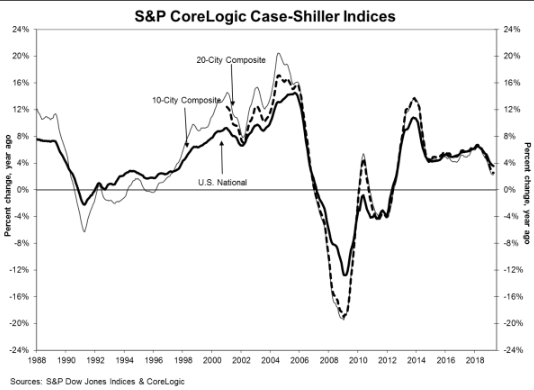In April, America’s home prices continued to appreciate slowly, according to the latest Case-Shiller Home Price Index from S&P Down Jones Indices and CoreLogic.
The report's results showed that April 2019 saw an annual increase of 3.5% for home prices nationwide, slowing from the previous month's pace of 3.7%.
The graph below highlights the average home prices within the 10-City and 20-City Composites.
(Click to enlarge)
Before seasonal adjustment, the National Index increased 0.9% month over month in April. The 10-City Composite and the 20-City Composite both posted a 0.8% month over month decrease.
After seasonal adjustment, the National Index recorded a month-over-month gain of 0.3% in April. Additionally, the 10-City Composite posted a 0.2% month-over-month increase, but the 20-City Composite did not experience an increase.
The 10-City and 20-City composites reported a 2.3% and 2.5% year-over-year increase for the month, respectively. Before seasonal adjustment, 19 of 20 cities reported increases, while 14 of 20 cities reported increases after the seasonal adjustment.
S&P Dow Jones Indices Director and Global Head of Index Governance Philip Murphy said April's home price gains continued in a trend of broad-based moderation.
“Year-over-year price gains remain positive in most cities, though at diminishing rates of change,” Murphy said. “Seattle is a notable exception, where the YOY change has decreased from 13.1% in April 2018 to 0.0% in April 2019.”
According to the report, Las Vegas, Phoenix and Tampa reported the highest year-over-year gains among all of the 20 cities.
In April, Las Vegas led with a 7.1% year-over-year price increase, followed by Phoenix with a 6% increase and Tampa with a 5.6% increase. Notably, nine of the 20 cities reported larger price increases in the year ending April 2019 versus the year ending March 2019.
“The national average 30-year fixed mortgage rate rose from below 4% in late 2017 to briefly reaching almost 5% by the latter part of 2018. Peak YOY changes in the 20-City Composite coincided with the upward turn in mortgage rates during the first quarter of 2018,” Murphy said. “In 2019, mortgage rates reversed course again and the 30-year fixed mortgage rate is again under 4%, yet the YOY house price moderation that coincided with the 2018 uptick in rates has not changed course.”
Murphy said other industry statistics are consistent with his observation, which may indicate the market is normalizing.
“For example, the national supply of housing is trending upward and suggesting weaker demand. Perhaps the trend for the moment is toward normalization around the real long run average annual price increase,” Murphy said. “Comparing the YOY National Index nominal change of 3.5% to April’s inflation rate of 2.0% yields a real house price change of 1.5% — edging closer to the real long run average of 1.2% cited by David Blitzer last month.”







